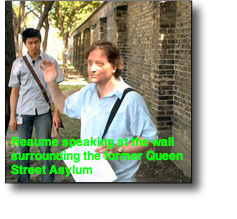Geoffrey Reaume from York and University of Toronto gave a fascinating talk in the History of Health and Medicine Lunchtime Seminar Series today. “From Activists to Archivists: Documenting Mad People’s History Since the 1970s,” explored both the formation of psychiatric survivors organizations  from the 1970s as well as the collection of artifacts allowing for study of these movements.
from the 1970s as well as the collection of artifacts allowing for study of these movements.
His talk reminded us of Allen Markman in NY, Kenneth Donaldson in Portland then more directly of local personalities such as Mel Starkman and Don Weitz. Reaume’s talk provided me with a wonderful exposure to the more human side of the mental health world and also put it into the context of other groups within society that battle with naming conventions. Very poignantly, Reaume also exposed the tremendously contentious area of attempting to remember the past when treatment has often been undertaken to eliminate such remembrances.
Reaume is currently engaged in two ongoing attempts to ensure that those that have been participants (willingly or unwillingly) in Toronto asylums past are not forgotten. The walls of the old Queen Street Asylum have been the site of local development over the past decade. Recently, the Psychiatric Survivors Association of Toronto has been successful in erecting a commemorative plaque that recognizes that the walls were constructed by the forced labour of patients confined to the Asylum. Their role in this construction is significant as is that most of it still stands solidly over 150 years after it was constructed. The wall is highly symbolic and a lasting tribute to patients whose experience of the system is worthy of continued remembrance and study. It is however a symbol of mixed emotions amongst those who have experienced confinement. There are calls to remove the reminder of many of the horrors experienced by clients of the system, even to our current time. Others, Reaume among them, seek to realize lessons lessons learned from past failures and to reflect on society’s attitudes towards those denied the ability to express their own wishes.
A second project is taking place at the site of the former Mimico Asylum (the Lakeshore in Etobicoke), where a graveyard containing the remains of 1511 patients who dies while confined is located. In the last two years, PSAT has made efforts to uncover grave markers and is still attempting to erect some form of commemorative marker for the entire site.
Both of these projects highlighted Reaume’s message of sensitivity to and respect for people in society who have been labeled and identified as lesser members, sometimes suffering injustice in due to societal naiveté or deliberate exclusion.
